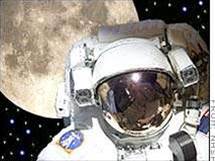
The six wheeled craft, similar to the Spirit rovers on Mars, will explore the surface to look for suitable landing sites for a manned mission and even scout out locations for permanent moon bases.
The 200kg rover is 1.5m high and has an average speed of 100 meters per hour. It was built by the Shanghai Aerospace System Engineering Institute in Minhang.
"We want to make it better than the early US and Russian rovers," institute director Luo Jian told the Chinese state news agency, without specifying the improvements.
Exploring the moon poses serious design challenges, however. The temperature difference of -180 degrees at night and 150 degrees during the day is difficult to cope with, and nights lasting 14 Earth days make solar power problematic.
To solve this the team built a small nuclear power plant, which would be the first time such a plant has been used on the moon.
It is not the first time that space craft have been equipped with nuclear power, however, and some of the nuclear material has fallen back to earth as contamination.
In 1996 the Russian Mars '96 space vehicle burned up in the atmosphere over South America, spreading half a pound of plutonium into the air.
When Apollo 13 flew it had 8.3lb of plutonium for a SNAP-27 (Systems for Nuclear Auxiliary Power) testing system, which fell to earth apparently intact and was recovered, only to be dumped in the Tonga Trench in the South Pacific.
More recently environmental groups protested at the launch of the Cassini space probe, whose nuclear engines contained 72.3lb of plutonium. The probe is currently in orbit around Saturn.

_(20).jpg&h=140&w=231&c=1&s=0)


.png&h=140&w=231&c=1&s=0)



_(26).jpg&w=100&c=1&s=0)

 iTnews Executive Retreat - Security Leaders Edition
iTnews Executive Retreat - Security Leaders Edition











_(1).jpg&h=140&w=231&c=1&s=0)



